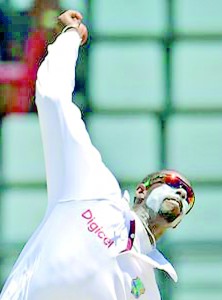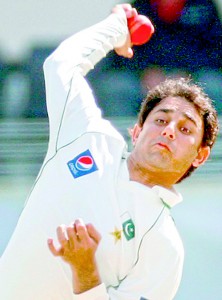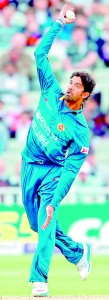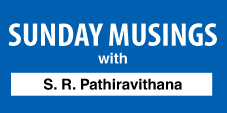Chucking it into the right slot
View(s):At the last International Cricket Council meeting in Melbourne where India, England and Australia took control of the proceedings of the game at international level and asserted their authority, many new recommendations were mooted, but, there was one that really caught my eye.
The recommendation came in the wake of Lankan off spinner Sachithra Senanayake being directed to laboratory tests on account of his bowling action during the fourth ODI in England.

Shane Shillingford of West Indies
The recommendation that drew my attention reads: “The ICC Board noted with concern the number of bowlers with suspected illegal bowling actions currently playing cricket and noted the recommendations of the ICC Cricket Committee and the CEC {Cricket Executive Committee} to revise processes to encourage umpires and referees to identify suspect bowlers with greater confidence, to use the expertise of the bio-mechanics working in this area to assume a greater role during the assessment process, and to allow for ongoing scrutiny of bowlers once they have been identified under the ICC procedures.”
Prior to this turn of events, there was another development that took place in India, a few seasons ago. There, in an earnest bid to eradicate the bent arm menace, the Indian cricket hierarchy took a blanket decision to give their umpires the onus of calling any bowler whom they suspected of bending their arm at the point of delivery at all levels of the game and especially at junior level. The Indians went to the extent of fining even the coaches who were encouraging such bowlers. The result was amazing. Now there are no bowlers with suspect actions coming through the Indian system.
Right now the truth is that it is the ‘Big Three’ that control the game. It is known that England and Australia do not encourage bowlers with suspect actions and India has now joined that club. What does this mean? There is going to be some action taken against all bowlers who are now in the arena with questionable actions and at the same time no bowler with such an action would be encouraged into the arena in the future.

Pakistan offie Saeed Ajmal
The return of Shane Shillingford to the West Indies Test team now has caused some problems to the umpires. Shillingford was reported for a second time in late 2013 and was subsequently cleared conditionally in March 2014. One of his variations — the doosra — was found to be illegal. His off-break and arm ball were cleared. But, now the umpires have to keep a watch on him to see if he is bowling the banned doosra. If he is caught bowling that delivery he will be banned by the ICC from bowling at international level for twelve months.
Now it is clear that there is growing concern about bowling actions and the bowlers to keep their bent arms within the limit of the permitted 15 degrees. Then the question is what is happening in our own back yard? There is a growing tendency for bowlers to use the bent arm in domestic cricket and in the last two under 19 tournaments there were several Lankan bowlers who were reported for having suspect actions and even some of our top notch school coaches who produce champion teams are encouraging such bowlers to thrive within their ranks.
In the last Under 19 World Cup, Priyamal Perera who hailed from St. Joseph’s and A.K. Tyronne the Richmondite, a bowler with a huge haul of wickets in the last two seasons, were reported on account of their bowling actions to the ICC. I was at a certain forum when some prominent senior cricket officials were running helter-skelter about the legality of the action of another bowler who hailed from a leading school. The final expert opinion was: yes, the bowler does have a problem with his action, but the umpires still have not reported about it; so the status quo remained. But, mind you this particular bowler had captured more than one hundred wickets this inter-school season.
Yet, the Sri Lanka Cricket sources say that there is a system in place to tackle the bent arm syndrome. They have appointed former international umpire T.H. Wijewardena to educate the local umpires about the importance of tackling this menace and the results are forthcoming. They say, in junior cricket once an umpire has reported the action of a bowler, the SLC authorities get down the bowler in question along with his respective coach. The bowler is then screened and the coach is educated about the minuses of the practice. Following this process, the bowler is worked upon and given guidelines to correct his action with the help of his coach.

Sri Lankan Sachithra Senanayake
The system prevails even in senior-level cricket. Now the bowlers are monitored by the umpires and if they have any doubts on the bowling action of a player, he will be reported. Then the bowler is called to the nets and worked on. However, the bowler is free to bowl at matches while the correctional work is in progress. Once the coaching department is satisfied with the legality of the deliveries of the bowler in question, he is cleared. However, if the bowler is reported for the second time, then he is suspended from bowling until he is cleared by the coaching department.
Now the question is if the system is in place, how does it work? Apparently there is something amiss. The local umpires are a different entity. They operate at local level and as we have learned there is a definite directive requesting them to report bowlers with suspect actions and according to the reports reaching us, the umpires are up to the game.
 But ironically, what is the level of their tolerance? If the local umpires are hauling up the bowlers with suspect actions how come two local bowlers each at the last two Under 19 World Cup tournaments were called by the international umpires.
But ironically, what is the level of their tolerance? If the local umpires are hauling up the bowlers with suspect actions how come two local bowlers each at the last two Under 19 World Cup tournaments were called by the international umpires.
I feel that there is a level of tolerance that is prevailing within the Lankan ranks. The calling is made according to the individual bowler and where he comes from and what level of cricket he is playing.
The homing truth that the local cricket authorities should understand is that the world game may not tolerate bowlers who go beyond the permitted 15 degrees for very long and every one of them will be tested and sent through the mill by the ICC. Obviously the ultimate loser is going to be Sri Lanka.
Just see the time energy and the cost the Lankan system has borne to bring up a bowler with suspect action to the international level and at that point, if the ICC steps in and stops him operating, the bowler has to go back to the drawing board and yet, may not be the same bowler what he was with his bent arm action. Wonder if he would be able to operate with the same variations with his new unbent arm?
Then for the local cricket authorities, they too will have to go back to the drawing board to get the replacement. Then if the bowler has been as effective as Senanayake while he was operating unhindered and been a part of a World Cup winning effort, what would be our plight? Remember the World Cup in real is only a few months away and definitely Senanayake was a part of our plans. With this drawback there is a chance that Senanayake may be subjected to certain restrictions by the ICC in his second coming.


